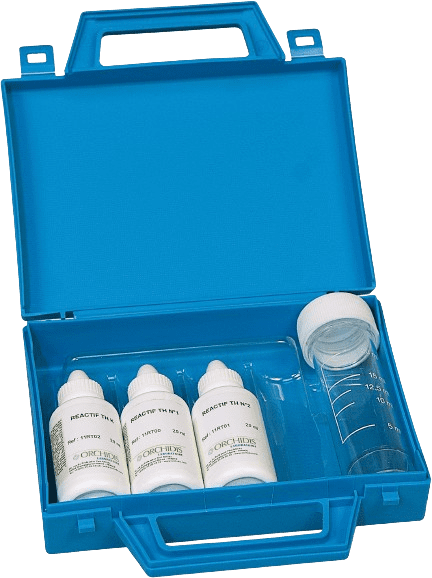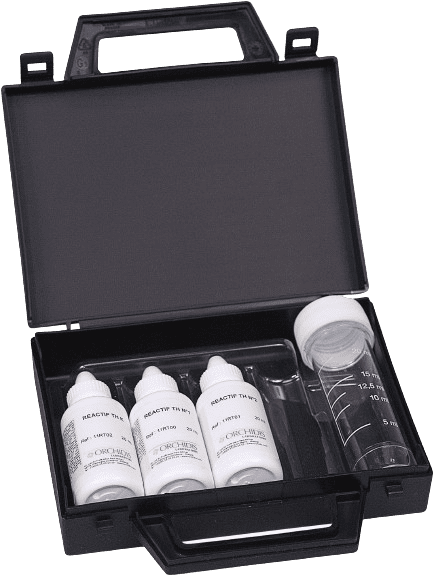


Choose our Alkalinity TA (AT Alkalimetric title) test kit, Alkalinity TAC (CAT Complete Alkalinity Title) test kit or combine both for a comprehensive analysis. The CMR-free TA indicator is also available.
Alkalinity TA (AT Alkalimetric title) is also known as p-alkalinity
Total alkalinity TAC (CAT Complete Alkalinity Title), is also known as m-alkalinity (methyl orange alkalinity) or acid demand for KS4.3
1KT006. p-Alkalinity Test Kit – 100 tests
1KT016 p-Alkalinity Test Kit (CMR-free) – 100 tests
1KT008. m-Total Alkalinity Test Kit – 30 tests
1KT098 p-Alkalinity / m-Total Alkalinity Test Kit – 100 tests
1KT099 p-Alkalinity / m-Total Alkalinity Test Kit (CMR-free) – 100 tests
The dropper titration method causes the color of the sample to change at the equivalence point. The number of drops needed for the color to change represents the alkalinity concentration.
Alkalinity plays a fundamental role in maintaining pH stability. It is a critical parameter in assessing surface water quality and analyzing the corrosive behavior of water in general water treatment and wastewater treatment. Extreme levels alter the taste of water and cause mineral buildup in industrial plant.
• Meets occasional or domestic use (for frequent testing in an industrial environment, burette methods with large reagent volumes are preferable)
• Option to add your logo
• CMR-free options available
• Accurate
• Fast and easy-to-use
• Compact and portable
• Affordable

AQUALABO, a French company, offers a combination of experience, innovation, international presence, adaptability, and ecological commitment, making it a trusted partner for water quality control.
Alkalinity TA (AT Alkalimetric title) or p-alkalinity is the alkalinity of water at a pH of 8.3, indicating the alkalinity relative to hydroxides and half the alkalinity relative to carbonates.
Total alkalinity TAC (CAT Complete Alkalinity Title), also known as m-alkalinity (methyl orange alkalinity) or acid demand for KS4.3, is used to determine the content of reactive basic compounds (hydroxides, carbonates, bicarbonates, etc.) up to a pH of about 4.3, thus including weak acids. In the case of natural water, it mainly represents the bicarbonate HCO₃⁻. In some highly polluted waters (wastewater), the CAT may also include weak organic acids (acetic, etc.). This may also occur in some very colorful natural waters (humic matter).
Alkalinity plays a fundamental role in maintaining pH stability. It is a critical parameter in assessing surface water quality and analyzing the corrosive behavior of water in general water treatment and wastewater treatment. Extreme levels alter the taste of water and cause mineral buildup in industrial plant.
Power plants: Optimizing heat transfer and reducing costs are essential in power plants. Maintaining the alkalinity of the cooling system preserves the protective oxide layer on the metal pipes. However, excessive alkalinity can lead to unwanted deposits.
Swimming pools: If the alkalinity of the water is too low, the pH can get out of control. If it is too high, there is a risk of scale deposits or cloudy pool water. The CAT of your water should be between 80 and 120 mg/l.
Anaerobic digestion: Alkalinity is essential to maintain optimal pH and ensure that the biological process is working properly.
Ammoniacal nitrogen removal: Constant monitoring of alkalinity is essential to ensure stable nitrification.
Drinking water treatment: Alkalinity acts as a pH buffer, promoting effective coagulation and softening, while controlling corrosivity in the distribution system.
Drinks manufacturing: Alkalinity monitoring is essential to ensure the quality of drinks, preventing spoilage due to incorrect alkalinity.
AQUALABO is a French manufacturer of instrumentation and chemical reagents for the control and analysis of water quality.
Contact us
© Aqualabo 2023 - All rights reserved